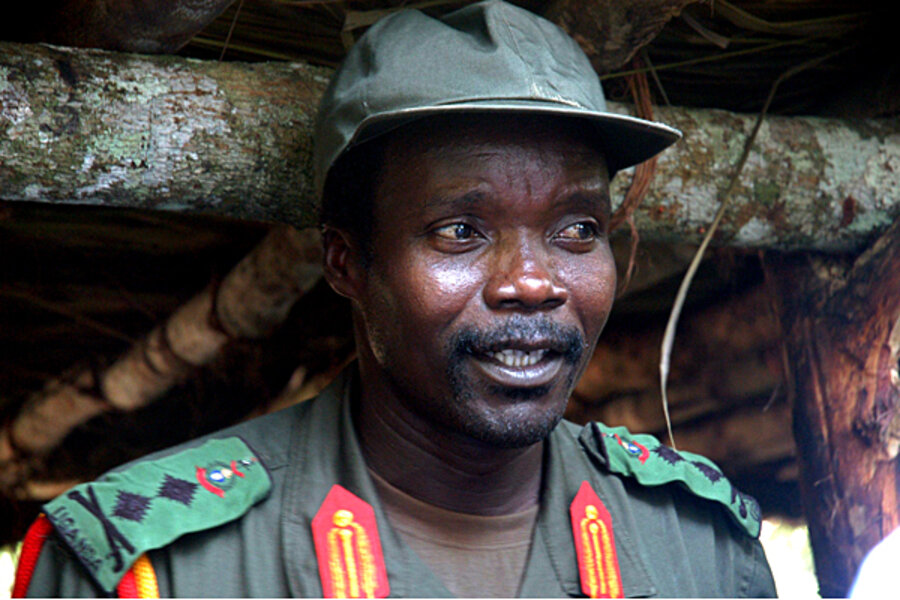Invisible Children video stirs US response: We're hunting down Joseph Kony
Loading...
| Washington
The State Department is praising a grass-roots social media campaign that is putting a spotlight on the elusive African warlord Joseph Kony and his heinous Lord’s Resistance Army (LRA).
But at the same time, US diplomats (and in some cases, their African counterparts) want the mostly young people who are suddenly caught up in the get-Kony cyber phenomenon to know this: The US government, central African governments, and numerous nongovernmental organizations have been working for some time to stop Mr. Kony and to address the needs of his victims, from escaped child soldiers to mutilated villagers.
“Certainly we appreciate the efforts of the group Invisible Children to shine a light on the horrible atrocities of the LRA,” said State Department spokeswoman Victoria Nuland, speaking to reporters Thursday.
But she also added, “As you know, there are neighboring states, there are NGO groups who have been working on this problem for decades.” Moreover, she said, the United States has been “very much involved” through support to the countries of East and central Africa where Kony’s army roams and pillages – in particular since last October, when President Obama ordered the dispatching of 100 special forces advisers to assist in the effort to bring down the LRA.
Ms. Nuland’s remarks reflected a bit of the amazement – and yes, frustration – that diplomats from Washington to Kampala, Uganda, have felt at seeing how a half-hour-long video posted on YouTube Monday has alerted millions of young people. It’s an issue that governments have struggled for years to expose and address.
The video, “Kony 2012,” the work of American Jason Russell and his Invisible Children organization, has logged more than 50 million views on YouTube and other video sites.
Nuland praised how the video is raising awareness about Kony and the LRA, saying that “hundreds of thousands of people around the world, especially young people, have been mobilized to express concern” for the people of central Africa who have been Kony’s prey.
She noted that, like many parents across America this week, State Department deputy spokesman Mark Toner learned about the video when his middle-schooler showed it to him.
The State Department, which under Secretary of State Hillary Rodham Clinton has increased efforts to employ social media in US public-diplomacy efforts, supports initiatives like the Kony video, Nuland said. “The degree to which this YouTube video ... increase[s] awareness” is helpful she said, even as she expressed a desire to see that greater awareness “increase support for the work that governments are doing, including our own government.”
Officials in Uganda, where the video is set, are also lauding the exposure of Kony and his horrendous deeds – even as they chide the videomaker for focusing on Uganda, where the LRA was chased out years ago.
“All this hoopla about Kony and his murderous activities is good in a sense that it helps inform those who don’t know the monster that Kony is,” Felix Kulayigye, Uganda’s Defense Ministry spokesman, told Reuters Friday. “But of course this is too late,” he added. The LRA was driven out of northern Uganda in 2005.
Kony and the LRA are now thought to be in neighboring Democratic Republic of Congo, where villagers in the dense forest that Kony prefers reported last month a string of telltale raids involving mutilations, theft, and abductions of children – boys to be soldiers, girls to be sex slaves.
The US troops are operating from a base in the Central African Republic and are advising the armies of a number of countries. But they’re not taking part in any raids themselves. Ugandan forces are thought to be the most capable in a campaign that ranges over a large swath of rugged and inaccessible terrain, regional analysts say. But they note that the Ugandan military is barred from entering Congo.
One goal of the Kony video appears to be to preempt any thoughts Mr. Obama might be having of bringing the 100 military advisers home.
Some experts who praise the attention the video is heaping on the issue wonder if it might end up a flash in the pan. They note that books have been written about Kony and investigative reports have aired, but the awareness ultimately died down.
Of course it’s not clear that those efforts reached anything close to 50 million cyber citizens – and counting.







